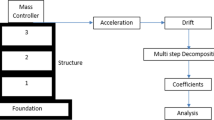Abstract
A self-recurrent wavelet neural network (SRWNN) is used to control suppression of vibration of an Euler–Bernoulli beam under excitation of a moving mass traveling along a vibrating path. The proposed control structure uses one SRWNN as an identifier and one as a controller. The SRWNN identifier is trained to model the dynamic behavior of the process and provide the SRWNN controller with information about system sensitivity. The SRWNN controller uses the sensitivity information provided by the SRWNN identifier to update weights and produce a signal that controls beam vibration. The gradient descent method and adaptive learning rates (ALRs) are used to update all SRWNN weights. The ALRs are obtained using the discrete Lyapunov stability theorem which guarantees the convergence of the proposed control structure. The performance and robustness of the proposed controller are evaluated at different mass ratios of moving mass to beam and for dimensionless velocity of a moving mass. The simulations verify the effectiveness and robustness of the controller.



















Similar content being viewed by others
References
Kononov AV, de Borst R (2002) Instability analysis of vibrations of a uniformly moving mass in one and two-dimensional elastic systems. Eur J Mech A Solids 21(1):151–165
Fryba L (1999) Vibration of Solids and Structures Under Moving Loads. Thomas Telford, London
Bilello C, Bergman LA, Kuchma D (2004) Experimental investigation of a small-scale bridge model under a moving mass. J Struct Eng 130(5):799–804
Sung Y-G (2002) Modelling and control with piezoactuators for a simply supported beam under a moving mass. J Sound Vib 250(4):617–626
Nikkhoo A, Rofooei FR, Shadnam MR (2007) Dynamic behavior and modal control of beams under moving mass. J Sound Vib 306(3–5):712–724
Prabakar RS, Sujatha C, Narayanan S (2009) Optimal semi-active preview control response of a half car vehicle model with magnetorheological damper. J Sound Vib 326(3–5):400–420
Pisarski D, Bajer CI (2010) Semi-active control of 1D continuum vibrations under a travelling load. J Sound Vib 329(2):140–149
Ryu B.-J, Kong Y.-S (2012) Dynamic responses and active vibration control of beam structures under a travelling mass. INTECH open Access Publisher
Flanders S, Burke LI, Yalcintas M (1994) Alternate neural network architectures for beam vibration minimization. ASME Publ AD 45:293
Chen CI, Napolitano MR, Smith JE (1994) Active vibration control using the modified independent modal space control (MIMSC) algorithm and neural networks as state estimators. J Intell Mater Syst Struct 5(4):550–558
Smyser C, Chandrashekhara K (1997) Robust vibration control of composite beams using piezoelectric devices and neural networks. Smart Mater Struct 6(2):178
Valoor MT, Chandrashekhara K, Agarwal S (2001) Self-adaptive vibration control of smart composite beams using recurrent neural architecture. Int J Solids Struct 38(44):7857–7874
Qiu Z, Zhang X, Ye C (2012) Vibration suppression of a flexible piezoelectric beam using BP neural network controller. Acta Mech Solida Sin 25(4):417–428
Ku C-C, Lee KY (1995) Diagonal recurrent neural networks for dynamic systems control. Neural Net IEEE Trans 6(1):144–156
Li X, Yu W (2002) Dynamic system identification via recurrent multilayer perceptrons. Inf Sci 147(1):45–63
Lin F-J et al (2006) An adaptive recurrent-neural-network motion controller for XY table in CNC machine. Syst Man Cybern B Cybern IEEE Trans 36(2):286–299
Lin F-J et al (2005) Hybrid controller with recurrent neural network for magnetic levitation system. Magn IEEE Trans 41(7):2260–2269
Pearlmutter BA (1989) Learning state space trajectories in recurrent neural networks. Neural Comput 1(2):263–269
Yu W (2004) Nonlinear system identification using discrete-time recurrent neural networks with stable learning algorithms. Inf Sci 158:131–147
Cao L et al (1995) Predicting chaotic time series with wavelet networks. Physica D 85(1):225–238
Choi J-T, Choi Y-H, Park J-B (2003) Stable intelligent control of chaotic systems via wavelet neural network. 제어로봇시스템학회 국제학술대회 논문집 pp. 316–321
Oussar Y et al (1998) Training wavelet networks for nonlinear dynamic input–output modeling. Neurocomputing 20(1):173–188
Zhang Q, Benveniste A (1992) Wavelet networks. Neural Net IEEE Trans 3(6):889–898
Zhang J et al (1995) Wavelet neural networks for function learning. Signal Proc IEEE Trans 43(6):1485–1497
Yoo SJ, Park JB, Choi YH (2005) Stable predictive control of chaotic systems using self-recurrent wavelet neural network. Int J Control Autom Syst. 3(1):43–55
Yoo SJ, Park JB, Choi YH (2005) Direct adaptive control using self recurrent wavelet neural network via adaptive learning rates for stable path tracking of mobile robots. In: American control conference, 2005. Proceedings of the 2005. 2005. IEEE
Wai R-J, Chang J-M (2002) Intelligent control of induction servo motor drive via wavelet neural network. Electr Power Syst Res 61(1):67–76
Oussar Y, Dreyfus G (2000) Initialization by selection for wavelet network training. Neurocomputing 34(1):131–143
Yoo SJ, Park JB, Choi YH (2007) Indirect adaptive control of nonlinear dynamic systems using self recurrent wavelet neural networks via adaptive learning rates. Inf Sci 177(15):3074–3098
Author information
Authors and Affiliations
Corresponding author
Rights and permissions
About this article
Cite this article
Ganjefar, S., Rezaei, S. & Pourseifi, M. Self-adaptive vibration control of simply supported beam under a moving mass using self-recurrent wavelet neural networks via adaptive learning rates. Meccanica 50, 2879–2898 (2015). https://doi.org/10.1007/s11012-015-0174-4
Received:
Accepted:
Published:
Issue Date:
DOI: https://doi.org/10.1007/s11012-015-0174-4




